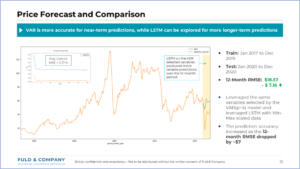Financial Planning and Scenario Analytics, including Exogenous Factors
Posted by | Fuld & Company
The CFO of a leading lubricants manufacturing company was looking for more accurate methods of financial planning to better invest the company’s cash and reduce operational costs.
Objective
To identify cost and revenue drivers and create a forecasting model that could reduce the current prediction error (vs. actuals) from ~8% to less than 5%.
Approach

- Conducted workshops with key client stakeholders to identify major parameters that impacted demand and sales, and understand clients’ current business models.
- Collected internal time-series data, such as wholesale and retail sales and volume, number of active product SKUs, number of manufacturing lines, production capacity utilization, number of warehouses, warehouse utilization, inventory, product returns, and destroyed in field.
- Collected key data related to external factors such as forex rates for USD, oil and gas prices, and other commodity prices.
- Tested various econometric models, such as SARIMAX, VAR, and LSTM, to identify the best-fit model; produced 3-, 6-, and 12-month forecasts while minimizing RMSE.
Outcome
The company improved forecasting accuracy by better understanding the key drivers of its sales and operational costs, and reducing the prediction error rate to 3.7%.
Algorithms Used: Econometric models such as SARIMAX, VAR, and LSTM
Tools
Tags: case study, Data analytics, financial planning, forecasting, manufacturing, Other Industries




















